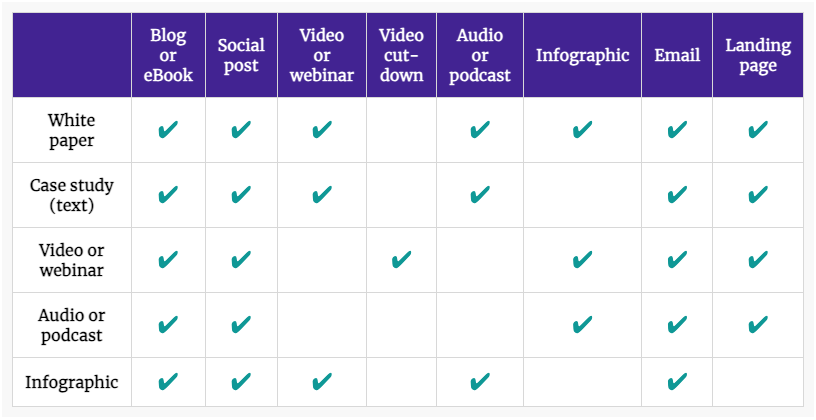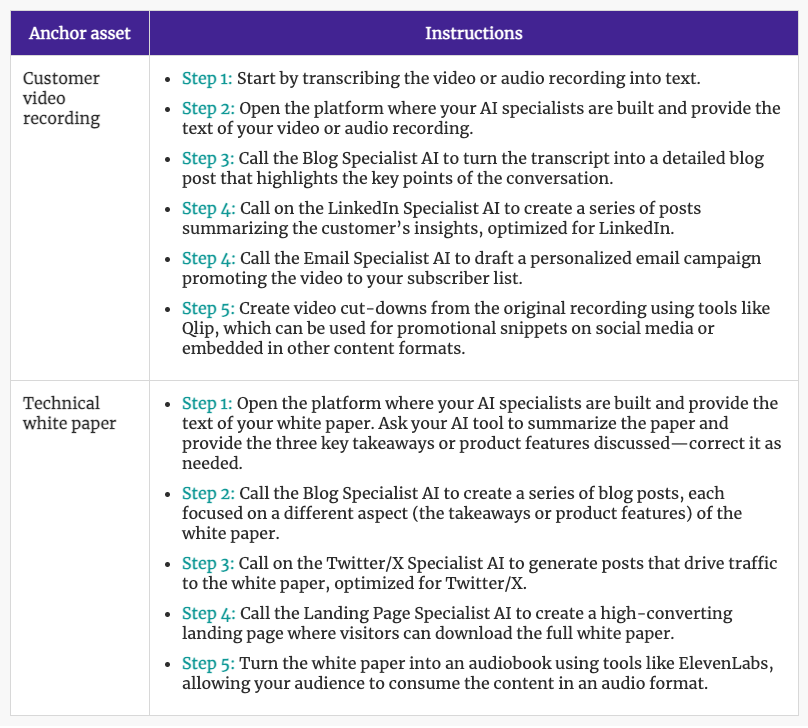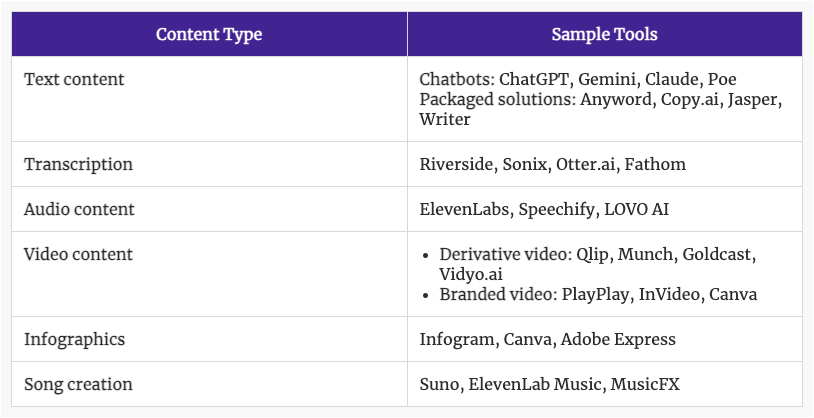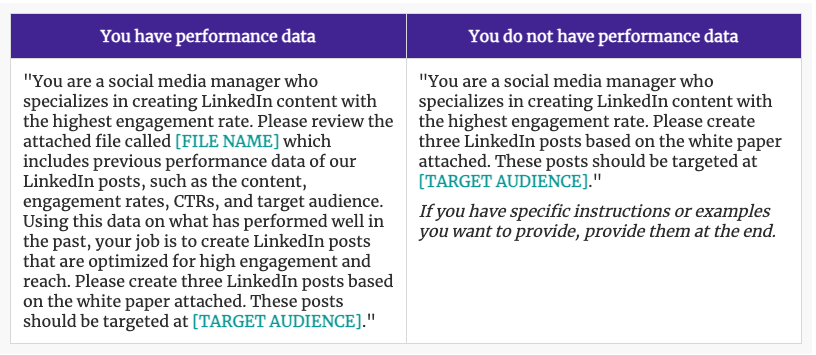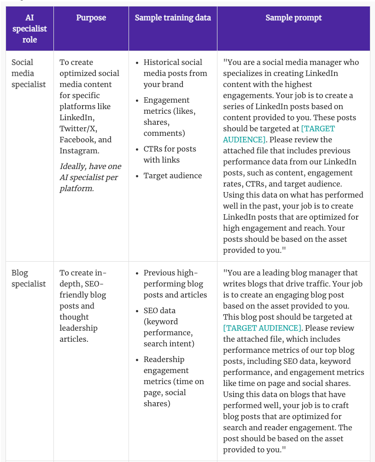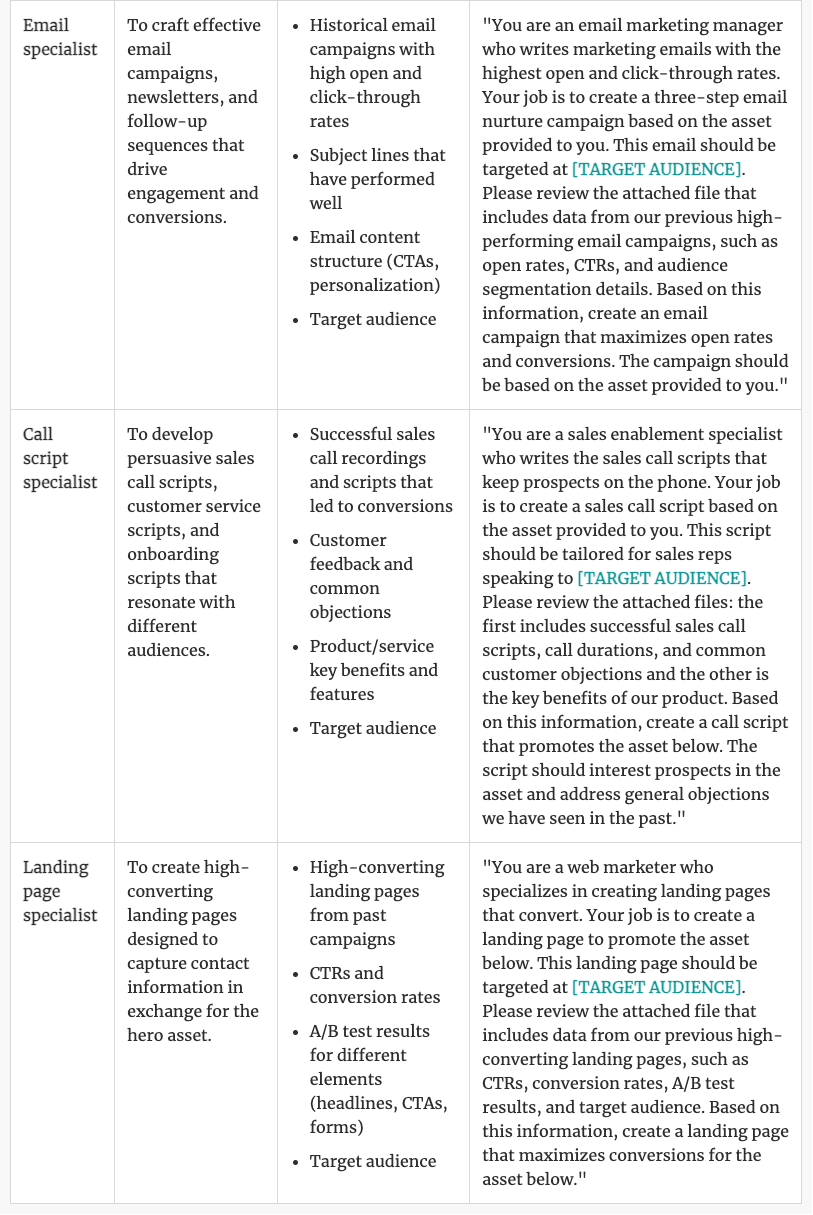Creating a powerful anchor piece of content—whether it’s a comprehensive whitepaper, an insightful webinar, or an in-depth case study—requires significant time, effort, and budget. Unfortunately, these assets often fail to reach their full potential. Many marketers deliver these assets in just one format or through a single channel, limiting their impact.
People consume content in diverse ways. Some gravitate toward long-form content, while others prefer quick, digestible insights. Some are drawn to visual content, while others prefer reading or listening. And different channels appeal to various segments of your audience—whether it’s LinkedIn for lunchtime browsing, YouTube for catching up on the latest trends, your website for in-depth research, or a podcast during a commute. To maximize the value of your core assets, meet your buyers where they are by offering content in the formats and channels they prefer.
This is where generative AI truly changes the game. AI makes it easy to adapt your content to meet these diverse preferences. By leveraging AI, you can quickly and cost-effectively transform a single asset into multiple pieces of tailored content. This is why it's no surprise that a recent Gartner study found that 49% of businesses are implementing or planning to implement generative AI for content marketing. Content repurposing doesn’t have to be a daunting task. Instead, it becomes a streamlined process that enhances your reach and effectiveness.
This guide will show you how to do this, providing practical prompts and strategies to help you dive into AI-powered content repurposing. Whether you’re looking to extend the life of your anchor assets or connect with more buyers in their preferred ways, this guide will equip you with the tools and insights you need to get started.
The importance of content repurposing
Content repurposing is the key to maximizing your return on investment (ROI) by meeting your audience with content that fits their needs across different formats and channels.
Meeting your audience’s needs. Repurposing content is an audience-focused strategy that expands your reach. For example, a customer video can be turned into a written case study, a blog post, social media snippets, and even visual evidence for presentations. Similarly, a whitepaper can be transformed into an infographic, a series of blog posts, social media updates, or even a video or a song! This approach increases the content’s reach and enhances its impact by delivering it in the most effective format for each audience segment.
Improving ROI. Repurposing content is a cost-effective strategy that minimizes the need to constantly create new content from scratch. Instead, you can extend the life and value of existing high-quality content by adapting it to different formats. This approach isn’t just about reusing content—it’s about enhancing its value. For example, turning a whitepaper into an infographic or a series of social media posts allows you to extract more value from that initial investment, reducing the need to produce as much new content.
Though not comprehensive or applicable to every situation, the table below offers sample asset types and content ideas for repurposing. By fully embracing content repurposing, marketers can make their content work harder, reach a broader audience, and drive better results—all while saving time and money.
ChatGPT and Poe offer users the ability to build custom AI models today—this feature is free for Poe users and requires a paid subscription for ChatGPT users. Google has announced it will offer this feature (called Gems) in Gemini, but as of this writing, it is not available yet.
Custom AI models are ideal for these use cases—they are trained on your data and style, are persistent, and can be “called” from any conversation. If these are unavailable to you, you can follow a similar process each time you want to create a specific type of content (see Appendix for how to repurpose content without custom AI models).
In a perfect world, your AI specialists should be created by, or in collaboration with, the channel experts themselves—for example, the social media expert or team should develop the social media specialists, the web expert or team should create the landing page specialists, and so on. By involving the right people and teams in the creation process, you ensure that the AI is trained with the most relevant best practices and high-quality data, leading to better outcomes. Below is a guide on how to set up your AI specialists, including the necessary training data and example prompts.
There are business-focused AI content marketing solutions, providers like Anyword, Copy.ai, Jasper, and Writer, that deliver these AI specialists out of the box. While they can save time and bring consistency to content, marketers who want more control over the training and output will find it more effective to build these AI specialists on their own.
How to build your AI specialist
In your preferred LLM, navigate to the screen to build your customized AI model. Name it, provide a description, upload the appropriate data (see table below), and prompt with something like the examples below.
These are just a few examples of AI specialists you can create. Marketers should develop an AI specialist for every content type they want to produce, using this format to ensure each piece of content is optimized for its specific purpose and audience.
Note: In the above prompts, you should fill in the [TARGET AUDENCE] with as granular or broad personas as make sense. For example, it can be as simple as “an IT security manager” or as detailed as “an IT security manager, working at a Fortune 100 retailer, responsible for securing the retail kiosks.”
How to call your AI specialists for text-based content
Now that you’ve built your text-based AI specialists as GPTs, Bots, or Gems, and have selected your non-text-based tools as your media AI specialists, the next step is to effectively use them to repurpose your hero assets into a variety of content formats.
Prepare your hero asset: Start by ensuring your hero asset is in its final form. This could be a video, a white paper, a keynote presentation, or any other substantial piece of content that you want to repurpose.
Select the appropriate AI specialist: Identify which AI specialist(s) you need based on the type of content you want to create. For example, if you’re turning a white paper into social media posts, call on your Social Media Specialist AI—usually done using the “@” symbol and the name you gave your specialist.
Provide context and guidelines: Upload or copy/paste the asset you want to repurpose. Give your AI specialist the necessary context by sharing details about your target audience, the desired tone, and any specific goals for the repurposed content. This ensures that the output aligns with your overall strategy.
Generate the content: Run the AI specialist to generate the content. The AI will create the output based on the information you provided and the training data it has received.
Review and refine the output: Review the AI-generated content and make any necessary adjustments to refine the messaging or format before finalizing the piece. As a marketer, your most important job is to ensure that the content is accurate, on-brand, and tailored to your audience so do spend some time here.
Deploy the content across channels: Once you’re satisfied with the content, deploy it across the relevant channels.
Example scenarios
To illustrate this process, here are two examples of how you can use AI specialists to repurpose different types of anchor assets:
By following this general approach, you can effectively repurpose your hero assets into a wide range of content formats, ensuring that your message reaches your audience in the most impactful way possible.
How to call your AI specialists for non-text-based content
Watch how to use various AI tools to build derivative content:
Large tech company slashes costs by 87% and time-to-market by 90% with AI
A leading tech company relied on agencies to repurpose anchor assets, such as white papers, into various content formats, a process that was both expensive and time-consuming. On average, each project cost $7,000 and took around 3 weeks to complete. The internal team reviewed the content twice: once after receiving the first draft from the agency, and again when the final copy was delivered, requiring 120 minutes of their time per project.
Transition to AI
To improve efficiency, the company piloted AI as a way to bring content repurposing in-house. Using AI, they transformed a single whitepaper into:
12 social media posts (3 paid and 3 organic posts for both Twitter/X and LinkedIn) to promote the white paper
A blog post that summarizes the key insights from the white paper
Landing page copy to effectively capture leads
3-step nurture email campaign designed to engage prospects and drive conversions
Content syndication summary tailored for distribution across partner networks
Results
87% cost reduction: Monthly AI tool subscription cost is $25/user, compared to $7,000 per agency project.
93% faster time-to-market: Content repurposing time was reduced from 3 weeks to just 10 minutes. The internal team spent an additional 90 minutes reviewing and editing the copy. The new assets were ready for market in 1 day.
Increased efficiency: The team maintained high performance and creativity with significantly fewer resources.
By leveraging AI, the company drastically reduced costs and time-to-market, while gaining greater control and efficiency in their content creation process. The projected time savings over the year, across approximately 200 anchor assets like webinars, white papers, and case studies, is estimated to save the company around $1.4 million.
Generate the content: Use the AI tool to generate the content based on your prompt.
Review and refine the output: Review the AI-generated content and make any necessary adjustments to fine-tune the messaging, tone, or structure before finalizing the piece.
Deploy the content across channels: Once you’re satisfied with the content, deploy it across the relevant channels.
Sample AI tools for content creation
While this is not a comprehensive list, this table highlights some of the most effective tools available for repurposing different types of content, ensuring that you can find the right AI solution for your specific needs.
To repurpose your content into other formats, such as audio, video, or infographics, use one of the many AI-powered solutions available (see Appendix for sample tools). Each of these tools works differently but generally speaking, they take as input your anchor asset (or a summary of it) and will output the desired media asset.
Maximizing the impact of repurposed content
Once you’ve repurposed your anchor assets into various content formats, it’s crucial to ensure that this content not only reaches your audience but also drives the desired outcomes. While this guide doesn’t focus on distribution strategies, here are a few key points to consider for maximizing the impact of your repurposed content. Note: Each type of content and platform has its own relevant metrics, so tailor your measurement approach accordingly.
Engagement: Look at metrics like likes, shares, comments, and time spent on content to gauge how well your content resonates with your audience.
Conversion rates: Monitor how effectively your content drives actions, such as form submissions, downloads, or purchases.
Views and reach: Track the number of views or the reach of your content to measure its visibility and potential impact.
Repurposing content with AI helps you make your content work harder—amplifying your message across multiple formats and channels with ease. As you deploy your repurposed content, keep an eye on the metrics that matter most to your goals, and continue refining your approach to ensure you’re achieving the best possible results.
Appendix
How to create content without custom AI models
If you haven’t created a GPT, bot, or gem, you can still use AI effectively by providing detailed, tailored prompts. The main difference is that you will need to work through this process each time you want to create repurposed assets:
Prepare your hero asset: Ensure your hero asset is finalized and ready for repurposing.
Select the appropriate AI tool: Choose your preferred AI tool (e.g., ChatGPT, Gemini, Claude, Poe).
Craft a tailored prompt: Here are two sample prompts for a LinkedIn post that you can use, depending on whether you have performance data to provide:

